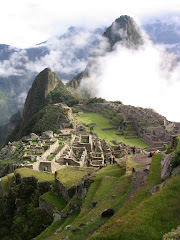Anyone who knows me knows I have control issues and a tendency to over-think (more accurately, over-worry) a situation, especially a foreign adventure. My family refers to this as the "Marie Petitin" effect, the symptoms of which most frequently consist of lying in bed awake all night, twitching with anxiety and endless mental loops imagining the worst possible outcomes (e.g., "We'll miss the bus...no we'll make the bus, but it will crash...no we'll make the bus, and it won't crash, but I'll have a brain tumor."). (Marie Petitin was my great grandmother; she invented anxiety.) The guidebooks don't help. My recommended Footprints guide warns visitors to Cusco to travel at night by taxi only, and beware of "strangulation robberies." The bus line we're taking is recommended because it is least likely to be robbed (although, because it's high tourist season, incidents of theft on the buses on this reputable line are way up, the thieves even working in cahoots with the drivers). And apparently, the areas around any bus station are dangerous, rife with low-lifes, and are to be encountered only if they absolutely cannot be avoided. Oh, and the fly-overs in Nasca (to see the weird Nasca lines, which can only really be enjoyed from above, I'm told) are the subject of lots of critical commentary on internet forums (is it fora?) because of a crash or two and increasingly frequent emergency landings on the Pan-American highway. Why would anyone travel to such a place, one might ask. Are these travel guides unnecessarily alarming? Or is it just me?
I eventually realized that if I were to write a travel guide to my homeland, I would include many of the same kinds of warnings. O.K., not the strangulation robberies, but I would certainly caution San Francisco visitors about traipsing through the Tenderloin, to keep an eye on your stuff on BART or Muni, and to watch your step to avoid tripping on a body on the sidewalk. This realization made me feel better, kind of.
Wednesday, July 30, 2008
Thursday, July 17, 2008
A little schadenfreude?
Pete, father of the world's most beautiful princess, regaled me the other night with predictions of the dire consequences that would befall me and my posse on this little outing. Let's see, they included altitude-induced constipation and marathon crying jags. He is not alone in suggesting that traveling with a 5 month old baby in a third-world country is crazy (and that's not even factoring in traveling with a smart but VERY demanding 5-year-old--who can REALLY push my buttons--or one crazy-assed dancing/singing earth motha'). But he doesn't (and the rest of you naysayers don't) know how tough my tribe is...and how we roll with the punches (which are sure to come, given that early on, for example, we will be trapped on a bus for, in one instance, 5 hours, and in another, 2 days later, 8 hours...that's assuming we get to the bus stations on time, etc.). You'll see, dammit.
Friday, July 11, 2008
Cultural/political/geophysical challenges we face
In prepping for the trip, and reviewing Peruvian news, I learned that in the last week or so (1) there's been an earthquake south of Lima, (2) riots in the streets protesting the guv-ment, (3) disruptions in train travel to Machu Picchu (because of those same riots), (4) a pissing match between the leaders of Bolivia and Peru that began when one called the other "fatter and less anti-imperialist," and (5) Peru has decided to embrace "vertical births" [you'll have to Google that one for yourself]. Pack light, everyone, and toss in your helmets.
Thursday, July 10, 2008
Andean eats
Peru is said to have one of the great world cuisines, and I plan to partake abundantly of some or all of the following for which Peru is reputed: ceviche (fish and other seafood marinaded in Peruvian lemon, coriander, aji and garlic); causa (yellow potatoes, lemons, pepper, hard-boiled eggs, olives, lettuce, sweet cooked corn, sweet cooked potato and fresh cheese, served with onion sauce); aguadito (thick rice and fish soup said to have rejuvenating powers); humitas (small, stuffed dumplings made with maize); aji de gallina (creamy, chicken-based dish with walnuts and parmesan); alpaca (yes, that kind of alpaca); pachamanca (meats wrapped and placed in a hole in the ground with hot stones); rocoto relleno (Andean peppers stuffed with quinoa and beef); polla a la brasa (grilled chicken); chicharrones (crispy, battered and fried meat); and the ubiquitous lomo saltado (beef stir-fried with vinegar, ginger, onions, chili, tomatoes, and fried potatoes, served with rice).
Also, as in Ecuador, where I managed to elude it, cuy (guinea pig) is a delicacy in Peru.
Peru is also home to a large Chinese and Japanese population (for reasons yet to be discovered), who brought their cuisine with them. Asian food inflected by a Latin American influence…how can that be anything but good?
And finally, it bears noting that the potato was “invented” in Peru, where something like 5,000 varieties still grow. You should also know that the United Nations has declared 2008 the International Year of the Potato. Yes, I will celebrate the potato.
Also, as in Ecuador, where I managed to elude it, cuy (guinea pig) is a delicacy in Peru.
Peru is also home to a large Chinese and Japanese population (for reasons yet to be discovered), who brought their cuisine with them. Asian food inflected by a Latin American influence…how can that be anything but good?
And finally, it bears noting that the potato was “invented” in Peru, where something like 5,000 varieties still grow. You should also know that the United Nations has declared 2008 the International Year of the Potato. Yes, I will celebrate the potato.
Subscribe to:
Posts (Atom)

